Students looking for the Bridges in Mathematics Kindergarten Home Connections Answer Key Unit 8 Computing & Measuring with Frogs & Bugs can find a better approach to solve the problems.
Bridges in Mathematics Kindergarten Home Connections Answer Key Unit 8
Bridges in Mathematics Kindergarten Home Connections Unit 8 Module 1 Session 1 Answer Key
Count the Cubes
Note to Families
In these activities your child will record numbers in 10s and is. Encourage counting on from 10(“10, 11, 12, 13, 14”), rather than counting by is.
Question 1.
Trace each number.

Answer:

Explanation:
The given numbers are traced as we can observe in the above image.
Question 2.
Count the cubes in each set and record the number.

Answer:
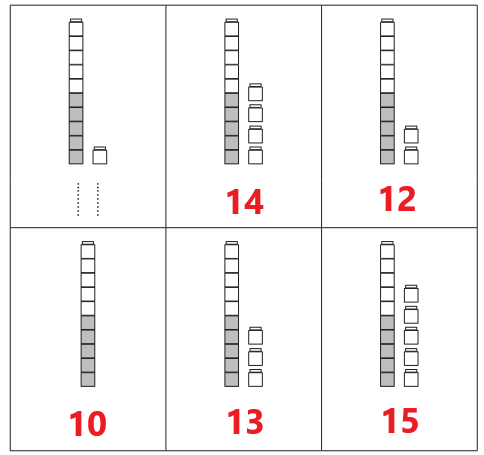
Explanation:
The above given cubes are counted in each set and recorded the numbers as we can observe in the above image.
Question 3.
How many cubes in each set?
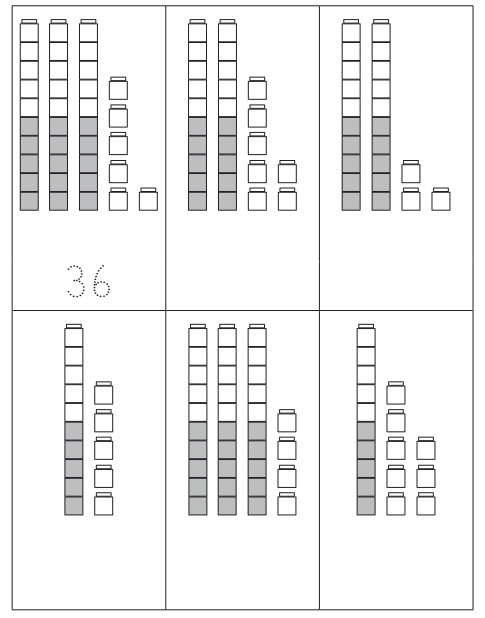
Answer:

Explanation:
In first set there are 36 cubes.
In second set there are 27 cubes.
In third set there are 23 cubes.
In fourth set there are 15 cubes.
In fifth set there are 34 cubes.
In sixth set there are 18 cubes as we can observe in the above image.
Bridges in Mathematics Kindergarten Home Connections Unit 8 Module 1 Session 5 Answer Key
Find What’s Missing
Question 1.
Trace each number.

Answer:

Explanation:
The given numbers are traced as we can observe in the above image.
Question 2.
Fill in the missing numbers.

Answer:

Explanation:
The missing numbers are filled as we can observe in the above image.
Question 3.
CHALLENGE Fill in the missing numbers.

Answer:

Explanation:
The missing numbers are filled as we can observe in the above image.
Question 4.
Fill in the missing numbers. Use the pictures to help.
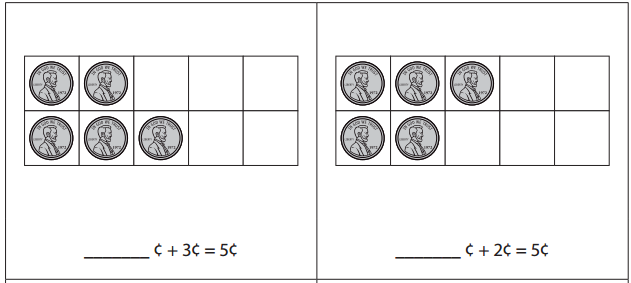
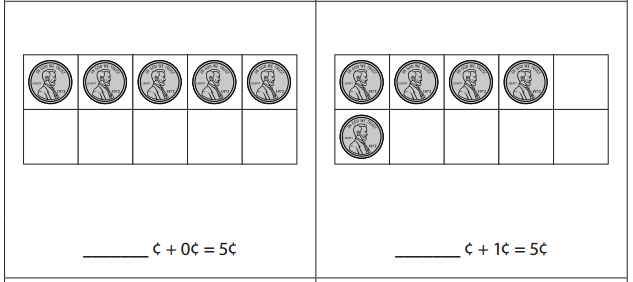
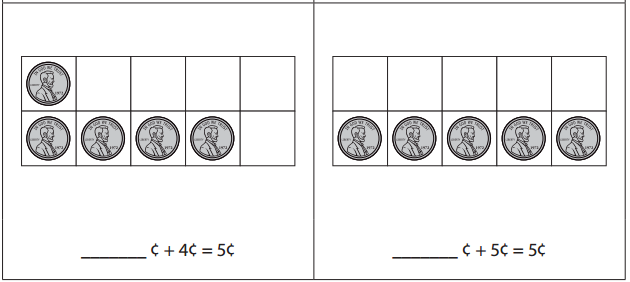
Answer:



Explanation:
By using the above given pictures, the missing numbers are filled as we can observe in the above image.
Bridges in Mathematics Kindergarten Home Connections Unit 8 Module 2 Session 2 Answer Key
Frog & Toad Probability
Question 1.
On the spinner below, Frog got 6 spins. Toad got 4 spins. Color the graph to show.
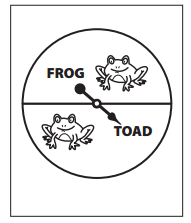
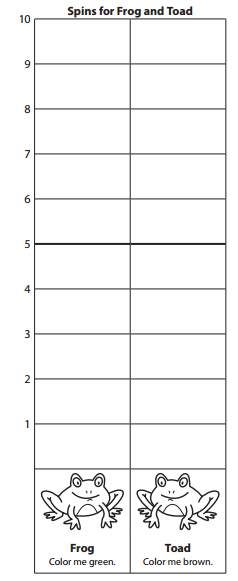
Answer:

Explanation:
Frog got 6 spins and colored with green. Toad got 4 spins and colored with brown as we can observe in the above image.
Question 2.
How many more spins did Frog get than Toad?
Answer:
Frog got 2 more spins than Toad.
Question 3.
How many spins did Frog and Toad get in all?
Answer:
Frog got 6 spins.
Toad got 4 spins.
6 + 4 = 10
Frog and Toad got 10 spins in all.
You will need a pencil and a paperclip for the spinner below, and green and brown crayons.
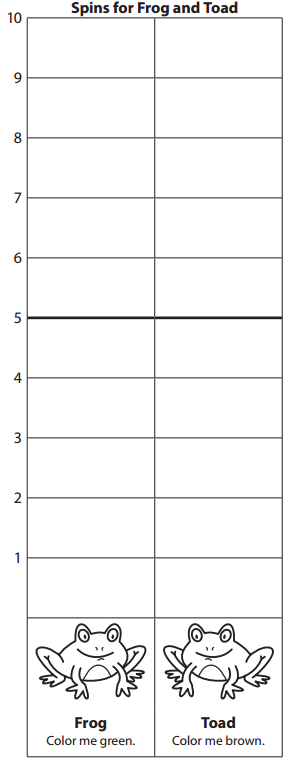
Answer:

Question 4.
Spin the spinner 10 times.
a. Each time it lands on Frog, color one of Frog’s boxes on the graph green, starting at the bottom.
Answer:
When the spinner lands on Frog each time the Frog’s boxes on the graph are colored with green, starting at the bottom as we can observe in the above image.
b. Each time it lands on Toad, color one of Toad’s boxes on the graph brown.
Answer:
When the spinner lands on Toad each time the Toad’s boxes on the graph are colored with brown, starting at the bottom as we can observe in the above image.
Question 5.
Who got more spins?
![]() Frog
Frog
![]() Toad
Toad
How many more?
Answer:

Frog got 4 spins more than Toad.
Question 6.
How many spins did Frog and Toad get in all?
a. How many more would Frog need to get 10?
Answer:
Frog needs 3 more to get 10.
b. How many more would Toad need to get 10?
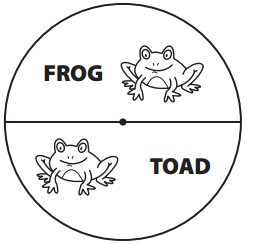
Answer:
Toad needs 7 more to get 10.
Bridges in Mathematics Kindergarten Home Connections Unit 8 Module 2 Session 5 Answer Key
Frog Story Problems
Use pictures and numbers to show how you solve the problem.
There were 6 frogs but some jumped into the pond. How many jumped into the pond?

Answer:

Explanation:
In the above given image, we can observe 3 frogs. But there was total 6 frogs. Some of the frogs jumped into the pound.
Subtract frogs jumped into the pound from total number of frogs.
6 – 3 = 3
Three frogs are jumped into the pound.
4 frogs. How many eyes?

Answer:
In the above given image, we can observe 4 frogs. Each frog has two eyes. Multiply 2 with 4 the product is equal to 8 eyes. 4 frogs have 8 eyes.
10 eyes. How many frogs?

Answer:
In the above given image, we can observe 10 eyes. Each frog has two eyes. Divide 10 by 2 the result is equal to 5 frogs. 5 frogs have 10 eyes.
Bridges in Mathematics Kindergarten Home Connections Unit 8 Module 3 Session 2 Answer Key
Place Value Tens & Ones
Note to Families
Students have been learning that “-teen” numbers can be thought of as “10 and some 1s.” In this Home Connection, they will be matching each double ten-frame with its equation.
Question 1.
Draw a line to match each double ten-frame with the correct equation.
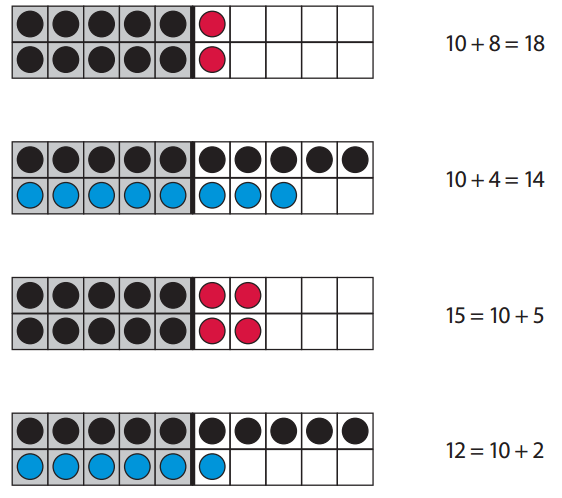

Answer:

Explanation:
Here I drawn a line to match each double ten-frame with the correct equation as we can observe in the above image.
Add (+) or subtract (-). Use counters or ten-frames, or draw pictures if you wish.
Question 2.
Solve each addition problem.

Answer:

Explanation:
Perform addition operation on above given numbers.
Add 10 with 4 the sum is equal to 14.
Add 10 with 7 the sum is equal to 17.
Add 10 with 6 the sum is equal to 16.
Add 3 with 2 the sum is equal to 5.
Add 5 with 4 the sum is equal to 9.
Add 3 with 3 the sum is equal to 6.
Question 3.
Complete each equation.
5 + 1 = _____________
8 + _____________ = 10
4 + 6 = _____________
1 + _____________ = 5
10 + ____________ = 16
10 + 7 = _____________
8 = 4 + _____________
10 = ___________ + 3
Answer:
5 + 1 = 6
8 + 2 = 10
4 + 6 = 10
1 + 4 = 5
10 + 6 = 16
10 + 7 = 17
8 = 4 + 4
10 = 7 + 3
Explanation:
Perform addition operations on above given equations.
Add 5 with 1 the sum is equal to 6.
To get the sum 10 add 8 with 2.
Add 4 with 6 the sum is equal to 10.
To get the sum 5 add 1 with 4.
To get the sum 16 add 10 with 6.
Add 10 with 7 the sum is equal to 17.
To get the sum 8 add 4 with 4.
To get the sum 10 add 7 with 3.
CHALLENGE Complete each equation.
9 + 10 = _____________
7 – 4 = ______________
19 – 10 = _____________
15 – 10 = ______________
Answer:
9 + 10 = 19
7 – 4 = 3
19 – 10 = 9
15 – 10 = 5
Explanation:
Perform addition and subtraction operations on above given equations.
Add 9 with 10 the sum is equal to 19.
Subtract 4 from 7 the difference is equal to 3.
Subtract 10 from 19 the difference is equal to 9.
Subtract 10 from 15 the difference is equal to 3.
Bridges in Mathematics Kindergarten Home Connections Unit 8 Module 3 Session 5 Answer Key
Patterns & Numbers
Question 1.
Trace the numbers.

Answer:

Explanation:
The numbers are traced as we can observe in the above image.
Question 2.
Write in the missing numbers.

Answer:

Explanation:
The missing numbers are filled in the above given image.
Question 3.
How many frogs? Write the total in the box.
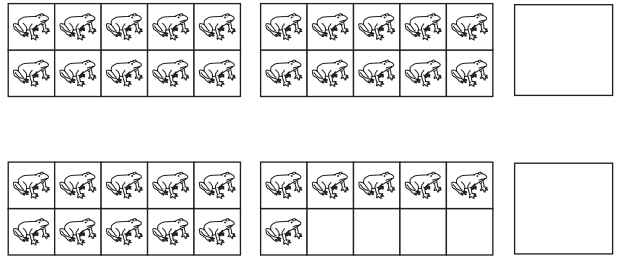
Answer:

Explanation:
The total number of frogs are counted and filled in the above given two boxes as we can observe in the above image.
Question 4.
Trace the numbers.

Answer:

Explanation:
The given numbers are traced as we can observe in the above image.
Question 5.
Write in the missing numbers.

Answer:

Explanation:
The missing numbers are filled in the above given image.
Question 6.
What comes next? Cut out the coins at the bottom of the page and tape or glue them down to show.

Answer:

Explanation:
In the above given image, we can observe two different patterns with coins. The next three coins are filled in the box.
Bridges in Mathematics Kindergarten Home Connections Unit 8 Module 4 Session 2 Answer Key
Tens & Ones
Note to Families
Students have been using materials to model and build equations, and matching the models with equations. Read the number words with your child, and point out the repeating “teen” part.
Draw a line connecting each ten-frame with its matching equation and number word. The first one is done for you as an example.
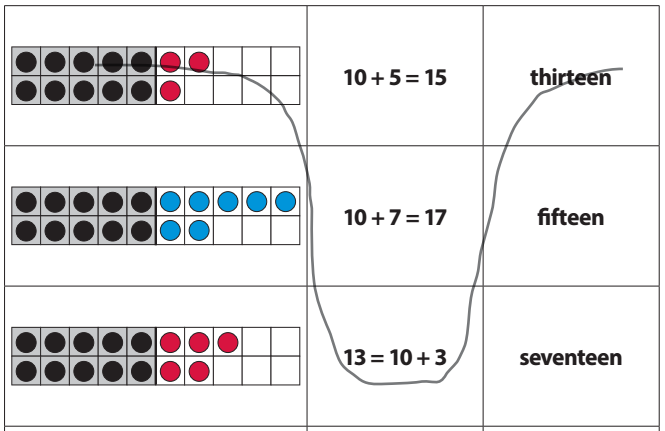
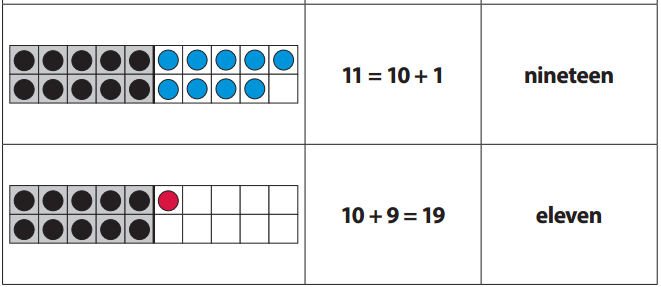
Answer:


Explanation:
In the above image we can observe a line is drawn to connect each ten-frame with its matching equation and number word.
Add (+) or subtract (-). Use counters or ten-frames, or draw pictures if you wish.
Question 1.
Solve each addition problem.

Answer:

Explanation:
Perform addition operation on above given numbers.
Add 10 with 4 the sum is equal to 14.
Add 10 with 3 the sum is equal to 13.
Add 10 with 5 the sum is equal to 15.
Add 10 with 9 the sum is equal to 19.
Add 10 with 1 the sum is equal to 11.
Add 10 with 6 the sum is equal to 16.
Question 2.
Complete each equation.
5 + 5 = ______________
8 + ___________ = 10
3 + 7 = _____________
6 + 4 = ______________
4 + 1 = _____________
3 + 2 = ______________
5 – 3 = ______________
4 = 5 – ______________
Answer:
5 + 5 = 10
8 + 2 = 10
3 + 7 = 10
6 + 4 = 10
4 + 1 = 5
3 + 2 = 5
4 = 5 – 1
Explanation:
Perform addition and subtraction operation on above given equations.
Add 5 with 5 the sum is equal to 10.
To get the sum 10 add 8 with 2.
Add 3 with 7 the sum is equal to 10.
Add 6 with 4 the sum is equal to 10.
Add 4 with 1 the sum is equal to 5.
Add 3 with 2 the sum is equal to 5.
To get the difference 4 subtract 1 from 5.
Question 3.
CHALLENGE Complete each equation.
11 + 10 = ______________
9 – 4 = ______________
17 – 10 = ______________
23 – 10 = ______________
Answer:
11 + 10 = 21
9 – 4 = 5
17 – 10 = 7
23 – 10 = 13
Explanation:
Perform addition and subtraction operation on above given equations.
Add 11 with 10 the sum is equal to 21.
Subtract 10 from 17 the difference is equal to 7.
Subtract 10 from 23 the difference is equal to 13.
Bridges in Mathematics Kindergarten Home Connections Unit 8 Module 4 Session 5 Answer Key
Year-End Interview
Note to Families
This Home Connection is an opportunity to talk with your child about what he or she learned and liked in math this year. We would also like to hear what you noticed about your child’s math development.
Ask your child the following questions and record the answers. 1 What did you learn in math this year?
Question 1.
What did you like most about math this year?
Answer:
I have learnt a lot this year in math about how to count number of objects and how to add, subtract, multiply and divide numbers.
Question 2.
What did you like most about math this year?
Answer:
I have learnt a lot this year in math about how to count number of objects and how to add, subtract, multiply and divide numbers.
Question 3.
What will you continue to work on during the summer?
Answer:
I will apply the math that I learnt this year in real life examples like counting number of things that I see daily and also the shapes of various things that I see in my day-to-day life.
Question 4.
Families, what did you notice about your child’s math development?
Answer:
My child has improved a lot in counting various objects now. He also spots differences between shapes of different objects that we see in our day-to-day life.